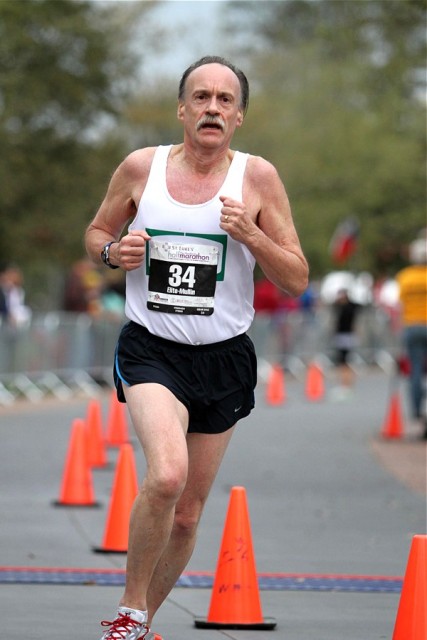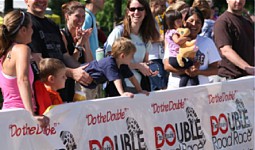UjENA FIT Club Running Interviews and articles with 100 Interesting People
Best Road Races and the UjENA FIT Club is speaking with 100 people who we feel have a lot to say about running, racing and fitness We will give you background information as will as their insights into the future. Be sure to post your feedback and comments.
Read All UjENA FIT Club Running Interviews
Posted Thursday, February 19th, 2015
by Bob Anderson, publisher of Double Runner magazine (Photo Bob Anderson with world record holder Julius Koskei wearing the yellow... Read Interview
Posted Monday, March 17th, 2014
The Chris Jones story is a running saga of epic proportions. Don't try this at home! (Photo - Leadville 100... Read Interview
Posted Sunday, March 23rd, 2014
Aging ever so gracefully at age 59 and forging a career record that becomes ever more impressive, Sharon Vos is... Read Interview
Posted Tuesday, November 5th, 2013
By David Prokop Editor Best Road RacesJulius Koskei (pronounced Kos-kay), who set the current world record in the Double Road... Read Interview
Peter Mullin
Tuesday, February 19th, 2013
Ujena Fit Club 2012 Male Runner of the Year 62-year-old Peter Mullin
By David Prokop As a geologist working with several international oil companies, Peter Mullin has spent decades essentially looking for oil, but now it turns out he’s found gold as a Masters runner in the 60-64 age group category. The 2012 Ujena Fit Club Male Runner of the Year, the 62-year-old native of Northern Ireland who’s lived in Houston since 1999, is the current U.S. champion in his age category in the 5K and the Half Marathon on the road and the 10,000 meters on the track. He ran 17:45 in the 5K to finish first in his age category at the 20th Annual Syracuse Festival of Races in Syracuse, N.Y., last September 30, and clocked 39:50 (in 90-degree heat!), again fastest in his age category, in the 10,000 meters at the U.S. Masters Track and Field Championships in Lisle, Ill. (near Chicago) in August. And in 2013 he’s picked up where he left off last year by winning the U.S. championship (60-64 age group) in the Half Marathon, running 1:23:43 in Melbourne, Fla., on February 3, only a couple of weeks ago. More significantly, where the Ujena Fit Club rankings are concerned and how the Runner of the Year is selected, he posted no fewer than 22 races averaging 6:13 for a total of 146 miles. His average age-graded score for the year was 88.24%. Peter is one of the top 60-64 runners in the country.
Upon graduation, he attended prestigious Cambridge University in England and put competitive running behind him, supposedly for good, although he would continue to train regularly but somewhat casually on the road in the years to come. In fact, at Cambridge, where he earned a degree in geology, he didn’t run track but was a rower on the second eight-boat (eight rowers per boat) representing his college, Peterhouse. If you’re wondering how a young man from Northern Ireland wound up attending Cambridge University, Peter explains, in a pleasant voice with an Irish accent, “Our school had a very good relationship with Cambridge and sent one or two students a year there.” He was one of those students. After graduating from Cambridge in 1972, he attended the University of South Carolina in Columbia, S.C., for two years, earning a Masters degree in geology. Then he went on to get a doctorate in geology from the University of Wales in Swansea, Wales. Now that he was Dr. Peter Mullin, with a Ph.D. in geology, he joined Shell Oil Company in 1978 as a geologist and worked in oil exploration with that firm for the next 25 years, living for several years at a time in different countries – first in Spain, then Holland, next Norway, back to Holland, and finally, in 1999, he came to Houston with Shell Oil. He left Shell in 2003 and joined Hess Corporation, one of America’s biggest independent oil companies. He worked with Hess until last year, and is now New Ventures Manager for Panatlantic Exploration in Houston. And all those years since his high school days, when he’d been a competitive runner and a pretty darn good one, Peter was doing just enough running “to feel fit,” but that was the extent of it. “I hate to admit it,” he says now, “but I was even a smoker for 15 years. I guess I’m proof that there’s still a chance of running success after smoking.” His casual relationship with running changed dramatically when he was in his 50s and working for the Hess Corporation, which happened to have a running club. On business trips Peter would sometimes run with an associate who was a member of the club. Noticing that Peter was a pretty good runner, the fellow suggested, “Hey, you should join our club.” Peter did, and that’s when his transformation into champion Masters runner began. Thus it was due to the fact Hess Corporation had a running club that Peter got back into competitive running (“Absolutely,” he says, “It’s definitely the case.”); his innate talent, competitiveness and dedication took over from there. He remembers the first race he won – the Chevron Jingle Bell Run, 5 miles, in Houston in 2006. In his latter 50s, he’d generally finish in the top three in the 55-59 age division in races. But then he turned 60, and it was an entirely different story. Now he was winning the 60-64 age group! “Runners are among the few people,” he reflects with some amusement, “for whom getting a year older can be a good thing.” Comments and Feedback
 Ujena Fit Club 2012 Male Runner of the Year - congrats Peter Mullin. You posted 22 races that totaled 5432 points. You won a Ujena Fit Club Elite Racing singlet and free entry and a two night hotel stay for the 2013 Double Road Race of your choice. You will have 10 to pick from. It will be great to meet... Ujena Fit Club 2012 Male Runner of the Year - congrats Peter Mullin. You posted 22 races that totaled 5432 points. You won a Ujena Fit Club Elite Racing singlet and free entry and a two night hotel stay for the 2013 Double Road Race of your choice. You will have 10 to pick from. It will be great to meet...Bob Anderson 2/19/13 3:39 pm  Peter Mullin from Houston is having an amazing year. He has already posted 19 races and leads our Fit Club Rankings with 5058 points. Dave Nevitt is second with 3931 points followed by Tyler McCandless. Who is going to be this year's Ujena Fit Club 2013 Male Runner of the Year? Peter Mullin from Houston is having an amazing year. He has already posted 19 races and leads our Fit Club Rankings with 5058 points. Dave Nevitt is second with 3931 points followed by Tyler McCandless. Who is going to be this year's Ujena Fit Club 2013 Male Runner of the Year?Bob Anderson 6/23/13 10:06 pm |
,,,,, |
Peter, who’s 5’9”, 152 pounds, runs about 30 races a year, ranging in distance from the mile to the Half Marathon. He does not run the marathon. As he explains, “I am somewhat better at the shorter distances. My best age-graded performance is actually the 5K. But the main reason why I don’t run the marathon is that I really don’t have the time to put in the mileage – I only run 30 miles a week, and I think to run the marathon well you need to be doing at least 60 miles a week. The other reason is I don’t want to run the risk of injury by doing the kind of training the marathon requires. As you get older, the risk of injury obviously becomes greater.” That said, Peter is one of the seemingly increasing number of runners who eschew the marathon in favor of more manageable and do-able shorter distances such as the Half Marathon (“The Half Marathon is becoming an increasingly popular and accepted distance,” he notes). But make no mistake about it, with a Half Marathon best of 1:21:55, he’s more than capable of cracking off a good marathon if he was fit (i.e., had done the mileage) and saw fit to run one. Asked what is his favorite distance, Peter says that he actually has two favorite distances – the 5K and the Half Marathon. “I like the 5K because you run hard and then sprint at the finish,” he explains. “And I like the Half Marathon because it’s a steady rhythm, it’s not a sprint rhythm. I don’t like the in-between distances as much.” In his training, Peter gears himself towards running 30 miles per week, and surprisingly, given his accomplishments as a runner, he does the majority of his training in a gym on a treadmill! At least he does at those times of the year when Houston is victim to a stifling combination of heat and humidity. He typically runs six days a week, less if he’s running a race – he takes a rest day before a race, two rest days if the race happens to be a Half Marathon. If he’s running on a treadmill, he might follow a weekly pattern of doing 6-4-6-3-7 miles Monday through Friday, running seven-minute pace on the longer runs, going slower on the shorter runs to facilitate recovery. He’ll also vary the speed of the treadmill during a workout to get an interval effect. And after the run, he’ll do a lot of muscle conditioning work, which would include stretching, using the foam roller, and weight training. At those times of the year when the Houston heat and humidity aren’t as oppressive, he runs outdoors – “Almost always in Memorial Park, which is the mecca for runners here in Houston.” He might do two circuits of the park on dirt trails (six miles), three circuits, maybe even four. The longest run he’ll do in training is 12 miles. “That’s uncommon,” he says. “More normally my longest run is nine miles.” Running on a treadmill as much as he does may actually be easier on his legs (“There’s definitely less pounding on the treadmill”), but, of course, it’s monotonous. For that reason, Peter thinks it’s easier to run outdoors on the roads or trails. Or as he puts it, “It’s easier to run on the roads – not from a physical point of view, but from a psychological point of view.” Talking to Peter Mullin, who was a casual runner all those years and returned to competitive running late, it’s clear he truly values this better-late-than-never commitment to running he’s found and appreciates what it’s done for him. “Although you may be aging, “ he says, “you’re still active – and it gives me a positive uplift passing a lot of younger people in races. I’m also very competitive, so winning my age group in a lot of races is very satisfying.” As for running races at an age when most people, even those who are fitness oriented, are going in the opposite direction on the exercise intensity scale, he says. “If you can do it, why not do it? As long as you can. So make the most of it, go for the races that you can – as long as you can.” Peter has been married to his Cuban-born wife, Sarita, since 1982 – they met when he was living and working in Spain. They have one daughter, Vivian, who’s in her 20s and is a Ph.D. candidate at Cambridge – her area of study is metabolic and cardiovascular diseases. Cambridge seems to run in the family. Like father, like daughter! One of the benefits of being selected Ujena Male Runner of the Year is that Peter gets a free entry and air fare to a Double Road Race™ of his choice. “I’ll give it a shot,” he says of competing in the Double. “It’s certainly interesting and challenging.” Peter joined the Ujena Fit Club in 2012. He had noticed on the Internet that a lot of his race results were appearing on the Ujena Fit Club Website. He took the next logical step. “As I said, I am competitive. So I thought, ‘Let’s join the club and post your results.’ “ Now, of course, he’s been selected 2012 Ujena Fit Club Male Runner of the Year. You know what they’d say about that at his old alma mater, Cambridge. Hip, hip, hooray! |

Copyright 2025 UjENA Swimwear · Site Map · Feedback · Tell A Friend · Nominate a Race
Leaderboard · UjENA 5K · Double Road Race · UjENA Jam · UjENA Network









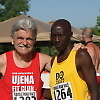
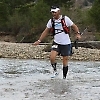
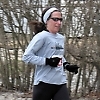

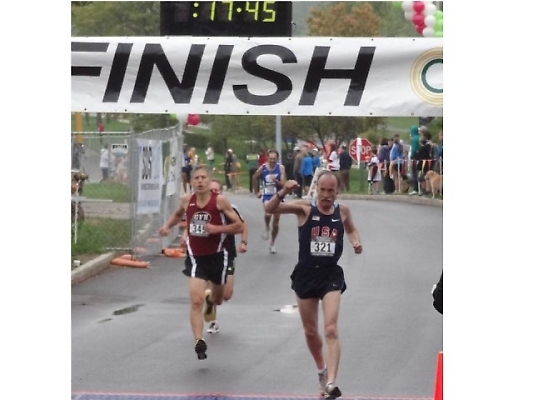
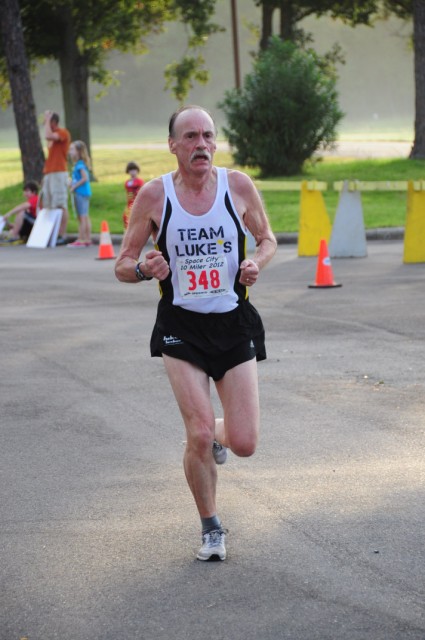 Peter Mullin was born Nov. 29, 1950 in Coleraine, Northern Ireland, United Kingdom, and started running in high school while attending Coleraine Institute. A member of both the track and cross-country teams, he was never a star runner, but he did win the county high school mile championship in a respectable time of 4:50.
Peter Mullin was born Nov. 29, 1950 in Coleraine, Northern Ireland, United Kingdom, and started running in high school while attending Coleraine Institute. A member of both the track and cross-country teams, he was never a star runner, but he did win the county high school mile championship in a respectable time of 4:50.